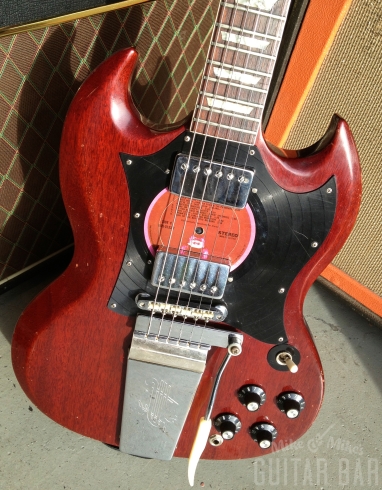By Michael James Adams
Seattle-based hot-rod guitar company Fastback is Fastback at it again with their newly-released pickup set: The Fastback ’59 Zebras. Manufactured by hand with care, these pickups claim to be modeled after the fabled P.A.F. pickups found on our favorite vintage bursts, but do they live up to the hype? Let’s find out!
A Horse of a Different Color
The Fastback ’59 Zebra pickups are hand-wound at Fastback’s Seattle HQ and spec’d out like the original PAFs we’re all so fond of. Visually, this set couldn’t look more right; the cream bobbins are just the right color, neither looking too yellow or too brown as aged parts so often do. Customers can expect a choice between AlNiCo 2 and 5 magnets for different tonal variations, with the 2 magnets exhibiting softer, spongier highs and lows with round mids than their ‘three more’ counterparts. The pickups come with a heavy wax bath to combat microphonics – breaking with true vintage tradition to the joy of most people – and single braid wire for easy installation.
Our set was wound slightly hotter than the measurements listed on the website (not that I’m complaining!) with the bridge measuring in at 8.4K and the neck at 7.6K. Installation was a breeze, and within no time I was slinging hot licks all over the place. Or whatever people do with guitars these days.
With these pickups loaded into my recently-acquired ’97 Squier Vista Super-Sonic, the difference in sonic fidelity was immediately identifiable. Of course the Zebras were a marked improvement over the stock Korean ‘buckers, but being a guitar tech I’m no stranger to vintage PAFs and I must say I was impressed. Fastback’s really hit the nail on the head here, folks.
Black and White and Cred All Over
The neck pickup had all of the airy, vocal midrange I expected from a pickup claiming to be a PAF, but few of them ever really get all the way there. The lows were pronounced but not overbearing, and the highs were sweet and supple, with a warmth and body all their own. Clean or dirty, this pickup retained the clarity and note definition associated with classic units. With overdrive, I was enveloped in heavenly fat tone.* Really a superb pickup in every way.
The bridge unit absolutely blew me away; creamy, chunky drive that stayed tight enough to appease my modern sensibilities, but was in no way sterile or shrill. The midrange was warm yet distinct, bringing to mind my favorite Jimmy Page sounds from How the West Was Won. Highs were stinging but round, while the lows were well-defined and present, but not as much as one might expect given current “PAF” offerings. Let me explain:
Though not as ample as I expected, the lows have a slightly different EQ curve, which seems to sacrifice some of the really round, fat low-lows in favor of a slightly higher bass frequency center, which means it never gets woofy or muddy. The E and A strings particularly had a very pleasant midrange kick, but were resplendent with a softer, woody overtone that immediately harkened back to the golden era of single-cut solid body guitars.
Again, the Jimmy Page comparison is apt here, because while his tone in HTWWW is freaking huge, I wouldn’t even begin to describe it as being as big and spectrum-killing as so many of our modern guitar ‘heroes’ might have you believe. No, Page’s tone is focused and cutting, neither overly bright or bassy. In a word, perfect – same as these pickups. I imagine the lows would be more pronounced in a more traditional mahogany body/maple top instrument, but I really dig the sound.
When used in tandem, these little beasts really come alive! The vocal qualities I mentioned earlier are magnified, with that quintessential open ‘ah’ vowel tone cutting through any dense mix. Literally anything I played with this selection sounded good, and that’s saying a lot. From legato minor-key runs to all-out, cacophonous freak out sessions, everything was gloriously tuneful.
I didn’t mention how well these pickups respond to tone knob variations. Even with a small twist from 10 to 8, the pickups warmed up beautifully, shifting the focus from brilliance to the woodier qualities we all associate with mahogany guitars. Thing is, this guitar isn’t mahogany, it’s basswood. Sure, the Super-Sonic isn’t the traditional guitar we’re all familiar with, but all of the warmth and lively sound I’d expect from a Les Paul was at my fingertips in a decidedly Fender package. Drop these pickups in a Les Paul, and I guarantee you’ll be thrilled.
Yay or Neigh?
Overall, I couldn’t be happier with these pickups. They’re every bit as magical as some of the original units I’ve played, with just a touch of modern wizardry thrown in. Too often, major pickup manufactures seem to be following in the current business model of most amp manufacturers, where doing absolutely everything comes before simplicity and good tone. We’re often left with amps that do everything averagely, with obscene amounts of high and low end which ultimately translates into a lackluster playing experience.
So you can understand why I really appreciate that Fastback has created a pickup that isn’t super hi-fi and doesn’t try to cover the breadth of the sonic spectrum. Instead of making a pickup that has huge amounts of earth-shattering low end and enough highs to blind a bat, it seems like Fastback tailor-made a set to suit full band situations with a focused, brilliant tone that cuts as much as it grooves. Undeniably fun, and easy on the wallet too!
Equine jokes.
Fastback ’59 Zebras
$80 each/$150 per set
Available direct or via Mike & Mike’s Guitar Bar
*Not to be confused with heavenly Fatone, which would be soooo dreamy















